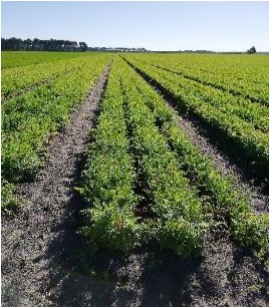A new flavi-like virus identified in populations of wild carrot
Deborah Schönegger, Armelle Marais, Chantal Faure, Thierry Candresse. https://doi.org/10.1007/s00705-022-05544-1. A new flavi-like virus was identified in the virome of wild carrots. It is tentatively named “carrot flavi-like virus 1” (CtFLV-1) and has a large genome of 21.8 kb with a single open reading frame encoding a large polyprotein with conserved RNA helicase and RNA-dependent RNA polymerase domains. CtFLV-1 is phylogenetically related to flavi-like viruses from arthropods, but is closest to a plant-associated virus, gentian Kobu-sho-associated virus (GKSaV), with which it could form the basis for a new genus of plant-associated viruses, for which the name “Koshovirus” is proposed
- 03 July 2023
- Yolanda Hernando Saiz
- < back to blog index
We report the discovery of a new flavi-like virus identified in wild carrots (Daucus carota subsp. carota), using a double-stranded(ds)RNA high-throughput sequencing (HTS) approach. The new virus, tentatively named “carrot flavi-like virus 1” (CtFLV-1), has a large genome of 21.8 kb that harbours a single open reading frame encoding a 7,078-aa polyprotein with conserved RNA helicase (Hel) and RNA-dependent RNA polymerase (RdRp) domains. The new virus is phylogenetically related to recently described flavi-like viruses from arthropods, but its closest relative is a plant-associated virus, gentian Kobu-sho-associated virus (GKSaV). A pairwise comparison showed that these two viruses share 38.4% amino acid (aa) sequence identity in their polyproteins and 73% and 47.8% aa sequence identity in their conserved RdRp and Hel domains, respectively. Based on their similar genome organization and phylogenetic relationship, GKSaV and CtFLV-1 could form the basis for a new genus of plant-associated viruses, possibly within the family Flaviviridae, for which the name “Koshovirus” is proposed.

< back to blog index
Recent posts
- Carrot populations in France and Spain host a complex virome rich in previously uncharacterized viruses
- VIROME ANALYSIS OF IRRIGATION WATER SOURCES PROVIDES EXTENSIVE INSIGHTS INTO THE DIVERSITY AND DISTRIBUTION OF PLANT VIRUSES IN AGROECOSYSTEMS
- Round table: https://youtu.be/XPYOCrXqqOQ
- Managing the deluge of newly discovered plant viruses and viroids: an optimized scientific and regulatory framework for their characterization and risk analysis
- A new flavi-like virus identified in populations of wild carrot
- Tomato brown rugose fruit virus in aqueous environments – survival and significance of water-mediated transmission
- First report of carrot torrado virus 1 (CaTV1) naturally infecting carrots in Spain
- VirHunter: A Deep Learning-Based Method for Detection of Novel RNA Viruses in Plant Sequencing Data
- Diversity of polerovirus-associated RNAs in the virome of wild carrots
- First report of Apium virus Y in wild carrot (Daucus carota ssp. carota) in Spain
- Tobamoviruses show broad host ranges and little genetic diversity among four habitat types of a heterogeneous ecosystem.
- Metagenomics show high spatiotemporal virus diversity and ecological compartmentalisation: virus infections of melon, Cucumis melo, crops and adjacent wild communities
- Web-based roundtable: Adoption and impact of high throughput sequencing in plant health: Seed testing, surveillance and certification
- Identification of two novel putative satellite RNAs with hammerhead structures in the virome of French and Spanish carrot samples
- Diversity and pathobiology of an Ilarvirus unexpectedly detected in diverse plants and global sequencing data
- First Report of Ranunculus White Mottle Ophiovirus in Slovenia in Pepper with Yellow Leaf Curling Symptom and in Tomato
- In-depth study of tomato and weed viromes reveals undiscovered plant virus diversity in an agroecosystem
- THE EXPANDING MENAGERIE OF PRUNUS-INFECTING LUTEOVIRUSES
- Molecular characterization of a new Prunus-infecting cheravirus and complete genome sequence of stocky prune virus
- Genetic differentiation and migration fluxes of viruses from melon crops and crop edge weeds
- Global advances in tomato virome research: current status and the impact of high-throughput sequencing
- Cont-ID: Detection of samples cross-contamination in viral metagenomic data
- Validation of high throughput sequencing as virus indexing test for Musa germplasm: performance criteria evaluation and contamination monitoring using an alien control
- HIGH THROUGHPUT SEQUENCING TECHNOLOGIES COMPLEMENTED BY GROWER’S PERCEPTION HIGHLIGHT THE IMPACT OF TOMATO VIROME IN DIVERSIFIED VEGETABLE FARMS
- BIOLOGICAL AND GENETIC CHARACTERIZATION OF PHYSOSTEGIA CHLOROTIC MOTTLE VIRUS IN EUROPE BASED ON HOST RANGE, LOCATION, AND TIME
- Risk perception associated with an emerging agri-food risk in Europe: plant viruses in agriculture
- First reports of Apple luteovirus 1, Apple rubodvirus 1 and Apple hammerhead viroid infecting apples in Belgium
- Evaluation of Methods and Processing for Robust Monitoring of SARS-CoV-2 in Wastewater
- Importance of associated weeds and cropping systems in shaping the viromes of horticultural crops. Ayoub Maachi PhD Thesis
- Use of high throughput sequencing and two RNA input methods to identify viruses infecting tomato crops.
- Complete genome sequence of malva-associated soymovirus 1: a novel virus infecting common mallow
- Cohombrillo-associated virus: a novel virus infecting Ecballium elaterium plants
- Known and new viruses identified in the virome of crops scanned by INEXTVIR
- Scanning the virome of Prunus : Identification and characterization of novel luteoviruses and Secoviridae members
- Complete genome sequence of almond luteovirus 1, a novel luteovirus species infecting almond
- INEXTVIR Mid-Term Check + Network Meeting 2 + School 2